
MAINE COON
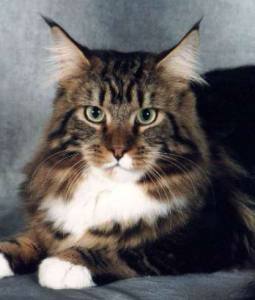
the European Champion Pandomainea Timberwolf
of the breeding WhiteForest
GENERAL: originally a working cat, the Maine Coon is solid, rugged, and can endure a harsh climate. A distinctive characteristic is its smooth, shaggy coat. A well proportioned and balanced appearance with no part of the cat being exaggerated. Quality should never be sacrificed for size. With an essentially amiable disposition, it has adapted to varied environments. SUGGESTED BREEDINGS by MENANDPETS.COM
No breeding to signal
if you want to know like signaling yours, contacts: marketing@inseparabile.it
HEAD SHAPE: medium in width and slightly longer in length than width with a squareness to the muzzle. Allowance should be made for broadening in older studs. Cheekbones high.
MUZZLE/CHIN: is visibly square, medium in length and blunt ended when viewed in profile. It may give the appearance of being a rectangle but should not appear to be tapering or pointed. Length and width of the muzzle should be proportionate to the rest of the head and present a pleasant, balanced appearance. The chin should be strong, firm and in line with the upper lip and nose. When viewed in profile the chin depth should be observable and give the impression of a square, 90-degree angle. A chin lacking in depth, i.e. one that tapers from the jaw line to the lip, is not considered strong, firm or desirable.
PROFILE: should be proportionate to the overall length of the head and should exhibit a slight concavity when viewed in profile. The profile should be relatively smooth and free of pronounced bumps and/or humps. A profile that is straight from the brow line to the tip of the nose is not acceptable, nor should the profile show signs of having a "break" or "stop."
EARS: Shape: large, well-tufted, wide at base, tapering to appear pointed. Set: approximately one ear's width apart at the base; not flared.
EYES: large, expressive, wide set. Slightly oblique setting with slant toward outer base of ear.
NECK: medium long.
BODY SHAPE: muscular, broad-chested. Size medium to large. Females generally are smaller than males. The body should be long with all parts in proportion to create a well-balanced rectangular appearance with no part of the anatomy being so exaggerated as to foster weakness. Allowance should be made for slow maturation.
LEGS and FEET: legs substantial, wide set, of medium length, and in proportion to the body. Forelegs are straight. Back legs are straight when viewed from GO BACK TO LIST. Paws large, round, well-tufted. Five toes in front; four in back.
TAIL: long, wide at base, and tapering. Fur long and flowing.
COAT: heavy and shaggy; shorter on the shoulders and longer on the stomach and britches. Frontal ruff desirable. Texture silky with coat falling smoothly.
PENALIZE: a coat that is short or overall even.
DISQUALIFY: delicate bone structure. Undershot chin, i.e. the front teeth (incisors) of the lower jaw overlapping or projecting beyond the front teeth of the upper jaw when the mouth is closed. Crossed eyes. Kinked tail. Incorrect number of toes. White buttons, white lockets, or white spots. Cats showing evidence of hybridization resulting in the colors chocolate, lavender, the Himalayan pattern; or unpatterned agouti on the body (i.e. Abyssinian type ticked tabby).
 MAINE COON CAT COLORS
MAINE COON CAT COLORS
EYE COLOR: eye color can be shades of green, gold, green-gold or copper. Blue-eyes or odd-eyes are also allowed for white or bicolor (including vans) patterned cats.
Solid Color Class
WHITE: pure glistening white. Nose leather and paw pads: pink.
BLACK: dense coal black, sound from roots to tip of fur. Free from any tinge of rust on tips or smoke undercoat. Nose leather: black. Paw pads: black or brown.
BLUE: one level tone from nose to tip of tail. Sound to the roots. Nose leather and paw pads: blue.
RED: deep, rich, clear, brilliant red; without shading, markings, or ticking. Lips and chin the same color as coat. Nose leather and paw pads: brick red.
CREAM: one level shade of buff cream, without markings. Sound to the roots. Nose leather and paw pads: pink.
Tabby Patterns
CLASSIC TABBY PATTERN: markings dense, clearly defined, and broad. Legs evenly barred with bracelets coming up to meet the body markings. Tail evenly ringed. Several unbroken necklaces on neck and upper chest, the more the better. Frown marks on forehead form an intricate letter “M.” Unbroken line runs back from outer corner of eye. Swirls on cheeks. Vertical lines over back of head extend to shoulder markings which are in the shape of a butterfly with both upper and lower wings distinctly outlined and marked with dots inside outline. Back markings consist of a vertical line down the spine from butterfly to tail with a vertical stripe paralleling it on each side, the three stripes well separated by stripes of the ground color. Large solid blotch on each side to be encircled by one or more unbroken rings. Side markings should be the same on both sides. Double vertical rows of buttons on chest and stomach.
MACKEREL TABBY PATTERN: markings dense, clearly defined, and all narrow pencillings. Legs evenly barred with narrow bracelets coming up to meet the body markings. Tail barred. Necklaces on neck and chest distinct, like so many chains. Head barred with an “M” on the forehead. Unbroken lines running back from the eyes. Lines running down the head to meet the shoulders. Spine lines run together to form a narrow saddle. Narrow pencillings run around body.
PATCHED TABBY PATTERN: a patched tabby (torbie) is an established silver, brown, blue or blue-silver tabby with patches of red or cream.
Brown Tabby Color Class
BROWN TABBY (classic, mackerel): ground color brilliant coppery brown. Markings dense black. Back of leg black from paw to heel. White trim around lip and chin allowed. Nose leather and paw pads: black or brown desirable.
Brown Patched Tabby Color Class
BROWN PATCHED TABBY: ground color brilliant coppery brown. Markings dense black with patches of red.
Silver Tabby Color Class
SILVER TABBY (classic, mackerel): ground color pale, clear silver. Markings dense black. White trim around lip and chin allowed. Nose leather: brick red desirable. Paw pads: black desirable.
Silver Patched Tabby Color Class
SILVER PATCHED TABBY (classic, mackerel): ground color pale, clear silver. Markings dense black with patches of red and/or cream. White trim around lip and chin allowed. Nose leather: brick red desirable. Paw pads: black and/or pink desirable.
Red Tabby Color Class
RED TABBY (classic, mackerel): ground color red. Markings deep, rich red. White trim around lip and chin allowed. Nose leather and paw pads: brick red desirable.
All Other Tabby Colors Class
BLUE-SILVER TABBY (classic, mackerel, patched): ground color pale, clear silver. Markings a deep blue affording a good contrast with ground color. White trim around lip and chin allowed. Nose leather: old rose desirable. Paw pads: rose desirable.
BLUE TABBY (classic, mackerel, patched): ground color pale bluish Ivory. Markings a very deep blue affording a good contrast with ground color. Warm fawn overtones or patina over the whole. White trim around lip and chin allowed. Nose leather: old rose desirable. Paw pads: rose desirable.
CREAM TABBY (classic, mackerel): ground color very pale cream. Markings of buff or cream sufficiently darker than the ground color to afford good contrast but remaining within the dilute range. White trim around lip and chin allowed. Nose leather and paw pads: pink desirable.
CREAM SILVER TABBY (classic, mackerel): ground color offwhite. Markings cream. Undercoat white. Lips and chin the same shade as the rings around the eyes. Nose leather and paw pads: pink desirable.
CAMEO TABBY (classic, mackerel): ground color off-white. Markings red. White trim around lip and chin allowed. Nose leather and paw pads: rose desirable.
Brown Tabby & White Color Class (including Vans)
BROWN TABBY & WHITE (classic, mackerel): color as defined for brown tabby with or without white on the face. Must have white on bib, belly, and all four paws.
Brown Patched Tabby & White Color Class (including Vans)
BROWN PATCHED TABBY & WHITE (classic, mackerel): ground color coppery brown. Markings dense black but with distribution of white markings as descirbed in brown tabby with white. Color as described for patched tabby (torbie) with or without white on face. Must have white on bib, belly, and all four paws.
Silver Tabby & White Color Class (including Vans)
SILVER TABBY & WHITE (classic, mackerel): color s defined for the silver tabby with or without white on the face. Must have white on bib, belly, and all four feet.
Silver Patched Tabby & White Color Class (including Vans)
SILVER PATCHED TABBY AND WHITE (classic, mackerel): color as described for silver patched tabby (torbie) with or without white on face. Must have white on bib, belly, and all four feet.
Red Tabby & White Color Class (including Vans)
RED TABBY & WHITE (classic, mackerel): color as defined for the red tabby with or without white on the face. Must have white on bib, belly, and all four feet.
All Other Tabby & White Colors Color Class (including Vans)
TABBY & WHITE (classic, mackerel): color as defined for tabby with or without white on the face. Must have white on bib, belly, and all four paws. Colors accepted are blue, blue-silver, cream, cream-silver, cameo.
PATCHED TABBY AND WHITE (torbie with white): color as described for patched tabby (torbie) but with distribution of white markings as described in tabby with white and van tabby. Color as described for patched tabby (torbie) with or without white on face. Must have white on bib, belly, and all four paws. Colors accepted are blue or blue-silver.
Bi-Color Color Class (including Vans)
BLACK AND WHITE: a combination of black and white, with or without white on face. Must have white on bib, belly, and all four paws.
BLUE AND WHITE: a combination of blue and white, with or without white on face. Must have white on bib, belly, and all four paws.
RED AND WHITE: a combination of red and white, with or without white on face. Must have white on bib, belly, and all four paws.
CREAM AND WHITE: a combination of cream and white, with or without white on face. Must have white on bib, belly, and all four paws.
Parti-Color Color Class
TORTOISESHELL: black with patches of red or softly intermingled areas of red on both the body and the extremities. Presence of several shades of red acceptable. BLUE-CREAM: blue with patches of cream or softly intermingled areas of cream on both the body and the extremities.
Parti-Color & White Color Class
CALICO (including vans): white with unbrindled patches of black and red. White predominant on underparts.
DILUTE CALICO (including vans): white with unbrindled patches of blue and cream. White predominant on underparts.
TORTOISESHELL AND WHITE: color as defined for tortoiseshell with or without white on the face. Must have white on bib, belly, and all four paws.
BLUE-CREAM AND WHITE: color as defined for blue-cream with or without white on the face. Must have white on bib, belly, and all four paws.
Shaded & Smoke Color Class
CHINCHILLA SILVER: undercoat pure white. Coat on back. flanks, head, and tail sufficiently tipped with black to give the characteristic sparkling silver appearance. Legs may be slightly shaded with tipping. Chin, ear tufts, stomach, and chest, pure white. Rims of eyes, lips, and nose outlined with black. Nose leather: brick red. Paw pads: black.
SHADED SILVER: undercoat white with a mantle of black tipping shading down from sides, face, and tail from dark on the ridge to white on the chin, chest, stomach, and under the tail. Legs to be the same tone as the face. The general effect to be much darker than a chinchilla. Rims of eyes, lips, and nose outlined with black. Nose leather: brick red. Paw pads: black.
CHINCHILLA BLUE SILVER: undercoat white. Coat on back, flanks, head, and tail sufficiently tipped with blue to give the characteristic sparkling silver appearance. Legs may be slightly shaded with tipping. Chin, ear tufts, stomach, and chest, pure white. Rims of eyes, lips, and nose outlined with blue. Nose leather and paw pads: rose desirable.
SHADED BLUE SILVER: undercoat white with a mantle of blue tipping shading down from sides, face, and tail from dark on the ridge to white on the chin, chest, stomach, and under the tail. Legs to be the same tone as the face. The general effect to be much darker than a blue chinchilla. Rims of eyes, lips, and nose outlined with blue. Nose leather and paw pads: rose desirable.
SHELL CAMEO (red chinchilla): undercoat white, the coat on the back, flanks, head, and tail to be sufficiently tipped with red to give the characteristic sparkling appearance. Face and legs may be very slightly shaded with tipping. Chin, ear tufts, stomach, and chest white. Nose leather, rims of eyes and paw pads: rose.
SHADED CAMEO (red shaded): undercoat white with a mantle of red tipping shading down the sides, face, and tail. Face and legs may be a deeper shading than the rest of the body. Chin, ear furnishings, stomach and chest (ruff) to be white. The general effect to be much redder than the shell cameo. Nose leather, rims of eyes and paw pads: rose.
SHELL CREAM (cream chinchilla): undercoat white, the coat on the back, flanks, head and tail to be lightly tipped with cream. Face and legs may be very slightly shaded with tipping. Chin, ear furnishings, stomach and chest (ruff) to be white. Nose leather, rims of eyes and paw pads: rose.
SHADED CREAM: undercoat white with a mantle of cream shading down the sides, face and tail, face and legs may be a deeper shading than the rest of the body. Chin, ear furnishings, stomach and chest (ruff) to be white. Nose leather, rims of eyes and paw pads: rose.
SHELL TORTOISESHELL: undercoat white. The coat on the back, flanks and tail to be lightly tipped with black and shades of red. Face and legs may be lightly shaded with tipping. Chin, ear furnishings, stomach and chest (ruff) may be white to very lightly tipped with shading. Nose leather, rims of eyes and paw pads: rose to black, may also be patched.
SHADED TORTOISESHELL: undercoat white. Mantle of black and red shading down the sides, face and tail. Face and legs may be a deeper shading than the rest of the body. Chin, ear furnishings, stomach and chest (ruff) may be white to lightly tipped. The general effect is to be much darker than the shell tortoiseshell. Nose leather, rims of eyes and paw pads: rose to black, may also be patched.
SHELL BLUE-CREAM: undercoat white. The coat on the back, flanks and tail to be lightly tipped with blue and shades of cream. Face and legs may be lightly shaded with tipping. Chin, ear furnishings, stomach and chest (ruff) may be white to very lightly tipped with shading. Nose leather, rims of eyes and paw pads: rose to blue, may also be patched.
SHADED BLUE-CREAM: undercoat white. Mantle of blue and cream shading down the sides, face and tail. Face and legs may be a deeper shading than the rest of the body. Chin, ear furnishings, stomach and chest (ruff) may be white to lightly tipped. The general effect is to be much darker than the shell blue-cream. Nose leather, rims of eyes and paw pads: rose to blue, may also be patched.
BLACK SMOKE: white undercoat, deeply tipped with black. Cat in repose appears black. In motion the white undercoat is clearly apparent. Points and mask black with narrow band of white at base of hairs next to skin which may be seen only when fur is parted. Light silver frill and ear tufts. Nose leather and paw pads: black.
BLUE SMOKE: white undercoat, deeply tipped with blue. Cat in repose appears blue. In motion the white undercoat is clearly apparent. Points and mask blue with narrow band of white hairs next to skin which may be seen only when fur is parted. White frill and ear tufts. Nose leather and paw pads: blue.
CAMEO SMOKE (red smoke): white undercoat, deeply tipped with red. Cat in repose appears red. In motion the white undercoat is clearly apparent. Points and mask red with narrow band of white at base of hairs next to skin which may be seen only when fur is parted. Nose leather, rims of eyes and paw pads: rose.
CREAM SMOKE: undercoat white, deeply tipped with cream. Cat in respose appears cream. In motion the white undercoat is clearly apparent. Points and mask cream with narrow band of white at base of hairs next to skin which may be seen only when fur is parted. Nose leather, rims of eyes and paw pads: pink desirable.
TORTIE SMOKE: white undercoat, deeply tipped with black with patches of red or softly intermingled areas of red on both the body and the extremities. The presence of several shades of red is acceptable. Cat in repose appears tortoiseshell. In motion the white undercoat is clearly apparent. Face and ears tortoiseshell pattern with narrow band of white at the base of the hairs next to the skin that may be seen only when fur is parted. White ruff and ear tufts. Blaze of red or cream on face is desirable.
BLUE-CREAM SMOKE: white undercoat, deeply tipped with blue, with clearly defined patches of cream as in the pattern of the bluecream. Cat in repose appears blue-cream. In motion, the white undercoat is clearly apparent. Face and ears blue-cream pattern with narrow band of white at the base of the hairs next to the skin which may be seen only when the fur is parted. White ruff and ear tufts. Blaze of cream on face is desirable.
Shaded/Smoke & White Color Class (including Vans)
Note: any tortie & white colors or blue-cream & white colors will not have the van pattern
CHINCHILLA SILVER & WHITE: color as defined for chinchilla silver with or without white on the face. Must have white on bib, belly, and all four paws.
SHADED SILVER & WHITE: color as defined for shaded silver with or without white on the face. Must have white on bib, belly, and all four paws.
CHINCHILLA BLUE SILVER & WHITE: color as defined for chinchilla blue silver with or without white on the face. Must have white on bib, belly, and all four paws.
SHADED BLUE SILVER & WHITE: color as defined for shaded blue silver with or without white on the face. Must have white on bib, belly, and all four paws.
SHELL CAMEO (red chinchilla) & WHITE: color as defined for shell cameo with or without white on the face. Must have white on bib, belly, and all four paws.
SHADED CAMEO (red shaded) & WHITE: color as defined for shaded cameo with or without white on the face. Must have white on bib, belly, and all four paws.
SHELL CREAM (cream chinchilla) & WHITE: color as defined for shell cream with or without white on the face. Must have white on bib, belly, and all four paws.
SHADED CREAM & WHITE: color as defined for shaded cream with or without white on the face. Must have white on bib, belly, and all four paws.
SHELL TORTOISESHELL & WHITE: color as defined for shell tortoiseshell with or without white on the face. Must have white on bib, belly, and all four paws.
SHADED TORTOISESHELL & WHITE: color as defined for shaded tortoiseshell with or without white on the face. Must have white on bib, belly, and all four paws.
SHELL CALICO: white with unbrindled patches of black and shades of red. The coat on the back, flanks and tail to be lightly tipped with black and shades of red. Face and legs may be lightly shaded with tipping. Chin, ear furnishings, stomach and chest (ruff) may be white to very lightly tipped with shading. White predominate on the underparts of the cat.
SHADED CALICO: white with unbrindled patches of black and shades of red. Mantle of black and red shading down the sides, face and tail. Face and legs may be a deeper shading than the rest of the body. Chin, ear furnishings, stomach and chest (ruff) may be white to lightly tipped. The general effect is to be much darker than the shell calico. White predominate on the underparts of the cat.
SHELL BLUE-CREAM & WHITE: color as defined for shell bluecream with or without white on the face. Must have white on bib, belly, and all four paws.
SHADED BLUE-CREAM & WHITE: color as defined for shaded blue-cream with or without white on the face. Must have white on bib, belly, and all four paws.
SHELL DILUTE CALICO: white with unbrindled patches of blue and shades of cream. The coat on the back, flanks and tail to be lightly tipped with blue and shades of cream. Face and legs may be lightly shaded with tipping. Chin, ear furnishings, stomach and chest (ruff) may be white to very lightly tipped with shading. White predominate on the underparts of the cat.
SHADED DILUTE CALICO: white with unbrindled patches of blue and shades of cream. Mantle of blue and cream shading down the sides, face and tail. Face and legs may be a deeper shading than the rest of the body. Chin, ear furnishings, stomach and chest (ruff) may be white to lightly tipped. The general effect is to be much darker than the shell dilute calico. White predominate on the underparts of the cat.
BLACK SMOKE & WHITE: color as defined for black smoke with or without white on the face. Must have white on bib, belly, and all four paws.
BLUE SMOKE & WHITE: color as defined for blue smoke with or without white on the face. Must have white on bib, belly, and all four paws.
CAMEO SMOKE (red smoke) & WHITE: color as defined for cameo smoke with or without white on the face. Must have white on bib, belly, and all four paws.
CREAM SMOKE & WHITE: color as defined for cream smoke with or without white on the face. Must have white on bib, belly, and all four paws.
TORTIE SMOKE & WHITE: color as defined for tortie smoke with or without white on the face. Must have white on bib, belly, and all four paws.
BLUE-CREAM SMOKE & WHITE: color as defined for blue cream smoke with or without white on the face. Must have white on bib, belly, and all four paws.
CALICO SMOKE: white with unbrindled patches of black and shades of red. Black and red patches to have a white undercoat. White predominate on the underparts of the cat.
DILUTE CALICO SMOKE: white with unbrindled patches of blue and shades of cream. Blue and cream patches to have a white undercoat. White predominate on the underparts of the cat.
Other Maine Coon Cat Color Class
OMCCC (Other Maine Coon Cat colors): any other color with the exception of those showing hybridization resulting in the colors chocolate, lavender, the Himalayan pattern; the unpatterned agouti on the body (i.e. Abyssinian type ticked tabby) or these combinations with white.
above the CFA Breed Standards
after automatic translate from inseparabile.com
History
Allinizio of the century many thought that, for the characteristic tigratura of its cape and the large and inanellata tail, it was the result of a crossing with lorsetto lavatore. Lipotesi, obviously absurd, however has contributed to feeding the numerous history that are handed on on this race . C also who at all costs has intentional to confer regale unaura to this "peasant" cat, making it quite to come down from the six cats dAngora that Queen Maria Antonietta, during the French Revolution, would have put in but sending them in America.
The origins of the Maine Coon have created cos tantissime legends and conjectures. But nobody pu to be tried.
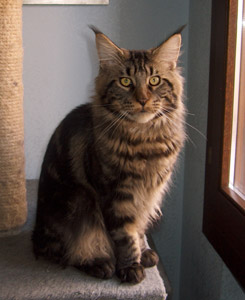
in the photo the National Champion Morgan Alwaro ( breeding Prince of Maine )
The probable theory devout, even if less colorful, the so-called "Darwiniana genesis", based on which the Maine Coon would be the result of an immense native genetic patrimony of the North American continent, with little or no interference from part delluomo. During lintero period of the colonization the ships berthed on the coasts Americans of the Northeast with their cargos and theirs coming from crews from all the world, to continuation of i which often c it was also some cat, "invited" to edge not as well as for the pleasantness of its company how much, if not, in order to make massacre of rats. Ream was be a matter of cats dogni, than the sailors dellepoca they appreciated less devout or to the second of their greater or smaller effectiveness ratticida, not sure for their greater or smaller beauty. But much probable that, between those micioni, all equal and all various ones, there was also some ancestors of the cats dAmerica, destined to transmit that gene of the gigantismo, we call it cos, that the birth of the splendid and most special cat like the Maine Coon would have favorite.
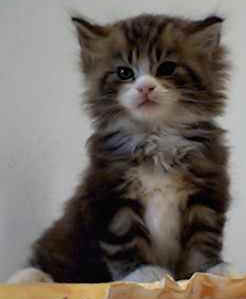
The Maine coon belongs however to one of the breeds devout ancient been born in North America the first official signalling laughed them to 1861 but, become much popular one initially, it came then omitted for the Persian Must wait for until first years Sixty in order assisting to the riscoperta one of the race, that it was recognized alone in 1976.
Selection
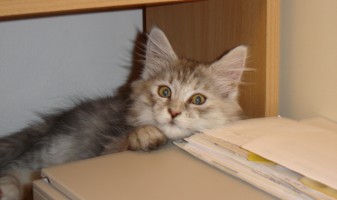
The photo of this beautifulst gattina (jade) be sended to us from our friend Selene
The decidedly various Maine coon odierno regarding the first subjects raises to you imposing, massive, of gigantic dimensions its salienti devout characteristics has been respected and increased has high legs with rich fingers of hair in order not to sink in the snow, cosi like the orecchie that, also being large and very open, are protect from abundant forelocks of hairs. The cape possesses a characteristic "natural fat person" who the protegge from the avversit atmospheric.
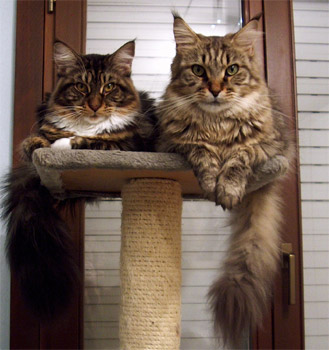
the International Champion Ginger Spice and the small Magdalene prince of Maine
( breeding Prince of Maine )
Councils and cures
It has an exceptional equilibrium and an extraordinary one adattabilit loves living allaperto but it does not scorn to the life housewife at all. And a fierce cat that faces every moment of the day with good Vivacit and dynamism. Before the rule for living with a cat that one "not to invade" the other people's spaces and respective libert and the this with a maine well coon and dobbligo. Just for the versatilit of its character, for lequilibrio and serenit an optimal companion also for the children and the old or sick persons. In spite of the size, a cat that does not eat a lot, but much habitual one, perci often becomes necessary to vary the food in order not to incur in dangerous alimentary imbalances. It does not demand particular cures or attentions, thanks to the idrorepellente hair. in kind, it calmly succeeds to get rid alone of the dead hairs and to maintain the cape in order. During the period of the dumb one pu to be useful to help it with a wide mesh comb a pair of times to the week
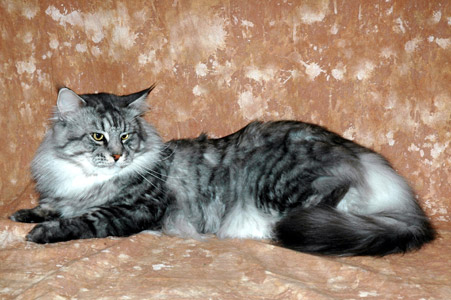
in the photo the International Champion Faboulous Freak of the wild Flower ( breeding Prince of Maine )
Character
But the fascination of the Maine coon resides above all on its good-natured and balanced character. All those who allinizio have been conquered from its exceptional physicist, have been astonished in verifying that the Maine coon above all a wonderful companion of life!
An other paradox: in spite of its imposing and vigorous walk and its beautiful look from "tenebrous", those that is used to define one "paste" of cat. Not only much kind one with its human family, the children., but particularly sociable and tolerant extension towards the other cats and all the domestic animals: rabbits, dogs, parrots... they do not disturb it at all! Same complicit with its congeneri: the Maine coon adores living within one trib: a cat much relative and mansueto. And much affectionate one without sticky being, insomma a "type" with which it is cohabited with facilit. Allinverosimile onlooker, adores to follow its landladies passopasso in every atmosphere of the house, moreover its passion for the game not labbandona, neanche in adult ET. Pu living in an apartment? S, on condition of mettergli to disposition a great tree for cats, where potr to scramble up and to vent all its energy. The Maine coon does not love the solitudine, therefore, if opted for a micio of this race, and remains house outside during lintera day, best to acquire two or to accompany it with an other domestic animal.
STANDARD
Ransom
them male catches up the 10 kg while the female, much devout small, arrives around to the 6 Kg.
Body
Of structure from average to large, body much muscoloso, boneses that give l to impression of solid power and robustness.
Legs
Of medium length in proportion to the body. Heavy skeleton, musculature much sturdy one. Large and round feet with good length of the hair interdigita them
Tail
Long, wide to the base, it is lost weight gradually until the tip. Full hair, along and flowing.
Neck
Sturdy and of medium length A lot along, not snello, of rectangular proportions, massive and heavy. Powerful solid musculature and
Orecchie
Much large, long, opened to the base, moderately appuntite, placed enough high on the head and adorned from the "forelocks of lynx"
Snout
Square, with stop sensitive allattaccatura of the head
Eyes
Of shape light oval, appears round when they are opens wide to you Grandi and very distances to you
Head
Large, devout long that wide, of medium proportions regarding the body
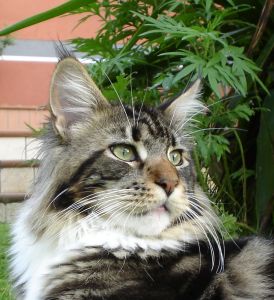
In the photo the beautifulst head of IVAN the gattone of Saretta85
The Capes
Semialong, devout short on the devout shoulders and along on flanks and ventre. Frontal Gorgiera to begin
Colors
The cape the devout Browns tabby the popular one, but is admitted the pure white man, and the other solid and diluted colors: blue, red, cream, the tigrati ones tabby blotched, mackerel and spotted, in the cited colors, and the silver tabby, beyond to these colors with white man.
In the photos some examples of the very many colors admitted for this race
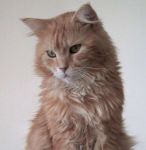
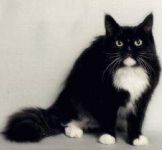
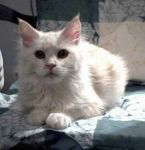
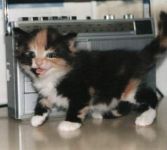
They are admitted also shells it of turtle, the tricolour one, the chinchilla, the silver smoke, the shell cameo, the shaded cameo, the black smoke, the blue smoke, the tortie smoke. The first recorded copy be a R-bianco.e.nero cat, in 1961. Admitted E' the white man in any quantit.
IF YOU WANT TO KNOW OF OF DEVOUT LAWS the INTERESTING INTERVIEW Of MRS. SUSANNA (breeding WhiteForest)
 |
| INSEPARABLE Sig.Ra SUSANNA of the WhiteForest breeding meets |
Statistics card maine coon activated the 25/08/2004
| You want to help us: you insert one of ours banner on your pages |
copyright
menandpets 18/12/2000 - 2010 |
QUICK LINK
© menandpets All rights reserved.
|